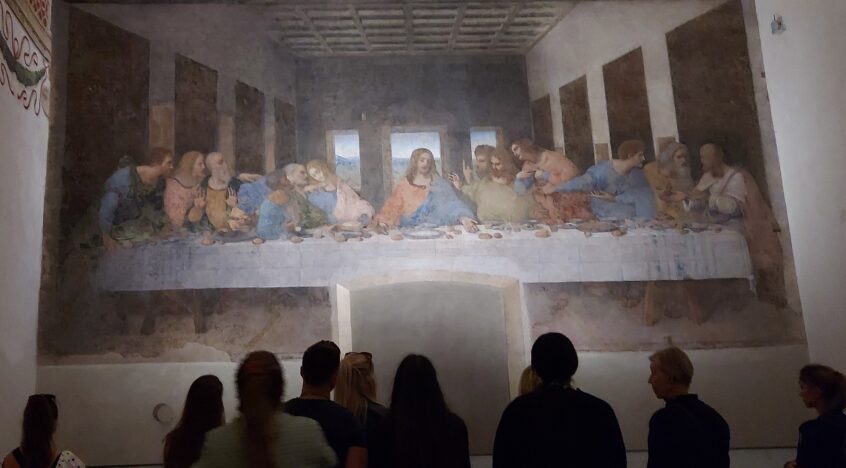Kathy and I made reservations to see Leonardo DaVinci’s Last Supper while we were still at home. We decided to go explore the neighborhood and have lunch nearby prior to our 1:15 reservation time.
The refectory of the church of Santa Maria delle Grazie, home to DaVinci’s masterpiece, is an upscale residential neighborhood. We admired the beautiful facades and the courtyards that led to most of the buildings.
We entered the church through what was at one time a walled garden for the nuns, then entered the church. Frescoes that cover the church walls and ceiling are being restored. We got to see the state they were in, faded and worn, and how they look once refreshed. In this church it is the ceiling that is the showstopper, a totally decorated confection of arches and frescoes. Each small chapel lining the church is dedicated to a different person or saint, is covered with frescoes, and filled with sculpture.
Outside we walked down the block in pursuit of lunch. On our way we stopped at a small stationery store, that became a highlight of the day. The proprietor handmakes most of the paper goods he sells—letters and envelopes, notebooks, albums and more. He spoke perfect English and was charming. Needless to say, both Kathy and I bought souvenirs.
Lunch was outdoors at a neighborhood café where we got to admire the style of the Milanese. They were so well dressed I felt shabby in my jeans.
Back near the church we met our tour guide. She explained the very strict rules about viewing the Last Supper. Twenty-five people are allowed to enter at a time. You must store all liquids and any large bags in lockers, you are allowed EXACTLY fifteen minutes to view the painting.
As we walked through a series of rooms, each one timed and locked behind us, she explained the history of the painting. It has had quite a history. It was painted by DaVinci for the church refectory (dining room). He used a new technique, tempera on plaster, rather than creating a fresco. His new technique allowed him greater detail and more vivid colors. Unfortunately, the technique was fragile and within forty years began to crumble. Recognizing that the painting was a masterpiece, local artists tried to repair it. That went on for decades.
During the second world war it was nearly destroyed by an allies bombing. It was saved only through covering it and using sandbags to protect it.
We finally got in to see the painting. It is far larger than I imagined. Painted in the 1400s, the details, expressions, placement of the bodies and overall composition are stunning. Fifteen minutes went by too quickly.
Outside, our guide explained about the most recent restoration begun in the 1970s that removed all of the layers of paint that had been put on over the centuries. The restoration took twenty years. It was re-frescoed to appear as it would have in DaVinci’s day. When they did the “excavation” of the painting, the faces appeared totally different, something that looked like a loaf of bread was a hand, and there were many other surprises.
Back to the hotel for a nap and then the tram to Navigli, a neighborhood of canals known for its nightlife. We found a café at the edge of the main canal. Seated facing the water at happy hour, we drank wine and asperol (an aperitif) and ate apertivo (snacks) as the sun slowly set. I could have stayed there forever watching kayakers on the canal, bicyclists, walkers, dogs, and trolleys pass by.
We finally tore ourselves away in search of dinner. Walking there we stopped multiple times because the views were so entrancing. Dinner was at a small local bistro, La Magolfa. A soccer game played on the television, watched, and cheered on by locals. The food (swordfish and grilled veggies) was excellent as was the bottle of red wine. It was also the least expensive meal we’ve had in Milan.

